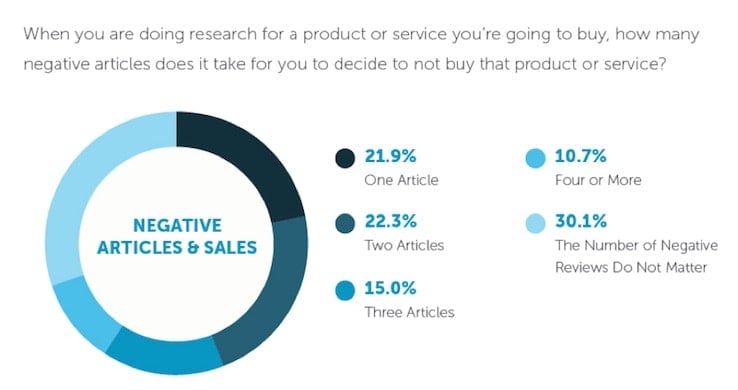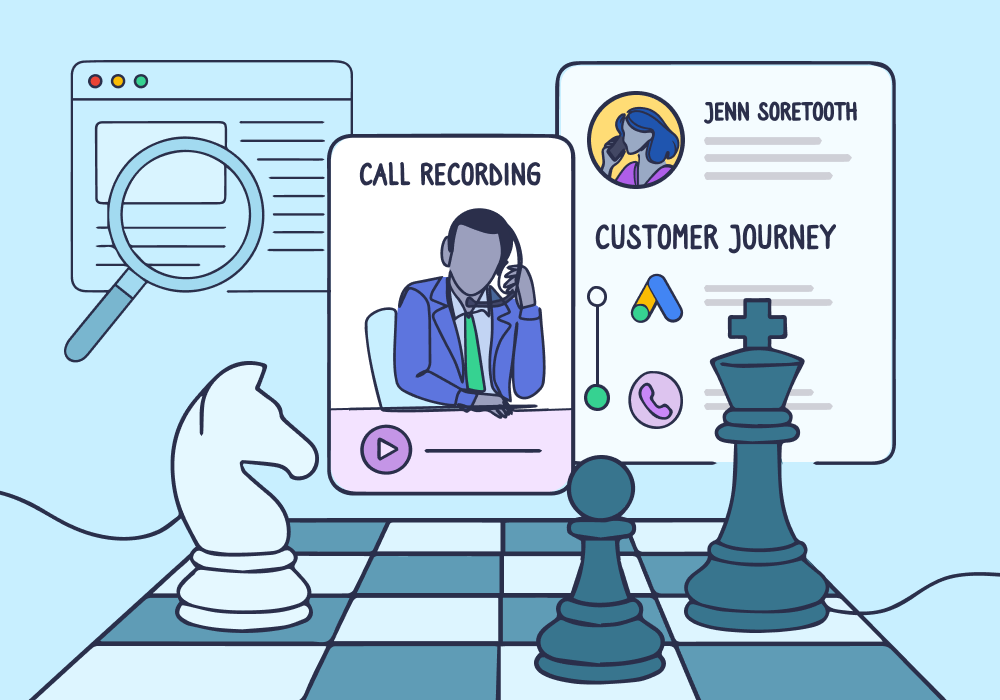
Everyone wants an edge, but not at the cost of integrity. More than 90% of Fortune 500 companies use competitive intelligence analysis (or CI analysis), yet even one unethical move can cause major damage. Hewlett-Packard’s 2006 “pretexting” scandal, which involved using deception to access phone records, led to felony charges and lasting brand fallout.
This guide shows how to gather meaningful competitor insights without crossing ethical or legal lines. From tracking public website updates to capturing competitor mentions in your own customer calls, we’ll explore what’s fair game and how to turn it into business value.
Tools like WhatConverts help teams stay on the right side of that line, surfacing competitor trends from inbound calls and tying them to specific campaigns honestly, transparently, and effectively.
Let’s explore how ethical CI analysis can fuel smarter strategy without the risks.
Why Ethical Competitive Intelligence Analysis Matters
Competitive intelligence analysis offers serious strategic advantages. But the way you gather that intelligence is just as critical as the insights themselves. Unethical practices might seem like shortcuts, but they come with steep risks to your brand, finances, and company culture. Here's why an ethical approach to competitive intelligence analysis is non-negotiable.
Protect Brand Reputation and Trust
One shady tactic can destroy years of brand-building. If your competitive intelligence analysis relies on deception or covert tactics, you risk losing customer trust. Just four negative news stories can drive away up to 70% of a company’s business.
Avoid Legal and Financial Risks
CI tactics aren’t just ethical considerations. They’re legal ones. The Economic Espionage Act and trade secret laws impose penalties up to $5 million and 10 years in prison for unauthorized access or use of confidential data. Even indirect involvement can lead to lawsuits, as seen in high-profile cases involving Coca-Cola and Volkswagen.
Preserve Fair Competition
Ethical competitive intelligence analysis ensures your strategy is rooted in product quality and execution, not manipulation. Staying compliant with ethical norms avoids antitrust issues and supports a market where success is earned, not stolen.
Foster a Culture of Integrity
How you conduct your research shapes how your team operates. Ethical analysis models transparency, builds trust across departments, and motivates employees to compete honestly. Studies show ethical cultures drive up to 23% higher engagement and profitability on average.
Key takeaway: Ethical competitive intelligence analysis protects your brand, minimizes legal exposure, and reinforces a winning culture. The smartest marketers win with strategy, not subterfuge.
Ethical Framework and Guardrails for Competitive Intelligence Analysis
A strong ethical foundation is what separates competitive intelligence analysis from corporate espionage. Without clear boundaries, even well-meaning marketers can drift into gray areas that carry serious consequences. That’s why every team needs a framework that’s grounded in industry standards, internal policy, and everyday decision-making.
Follow Industry Guidelines and Legal Standards
Professional organizations like SCIP (Strategic Consortium of Intelligence Professionals) offer a clear baseline: no misrepresentation, full legal compliance, and total honesty about who you are and what you’re doing. A simple rule of thumb? “If it feels wrong, it probably is.”
Legal boundaries matter, too. U.S. laws like the Economic Espionage Act make it a felony to obtain trade secrets through illicit means. Just because something isn’t technically illegal doesn’t make it ethical or smart.
Best practice: Competitive intelligence analysis should rely only on publicly available or permission-based data sources. No deception. No gray zones.
Build an Internal CI Policy
Don’t leave ethics to interpretation. A clear internal policy translates abstract values into specific behaviors. It should include:
- Permitted methods: Monitoring public sites, using surveys, collecting sales insights
- Prohibited tactics: Misrepresentation, scraping gated content, soliciting confidential info
- Training and governance: Regular education, leadership oversight, and ethics checkpoints
Review your policy periodically. CI norms shift as platforms evolve and new privacy regulations emerge.
Principles in Action: Living the Framework
Ethical competitive intelligence analysis comes down to four habits:
- Be honest about who you are – No fake personas or covert approaches.
- Use only public, consensual, or first-party sources – Websites, interviews, surveys, customer recordings and transcriptions, etc..
- Document everything – Keep a record of sources and collection dates.
- Use the “headline test” – If you wouldn’t want your tactic on the front page, don’t use it.
Key takeaway: A well-documented ethical framework ensures your competitive intelligence analysis remains trustworthy, effective, and legally sound. It empowers your team to gather insights confidently, without compromising your company’s reputation.
What You Can Do: Ethical Data Sources and Tactics
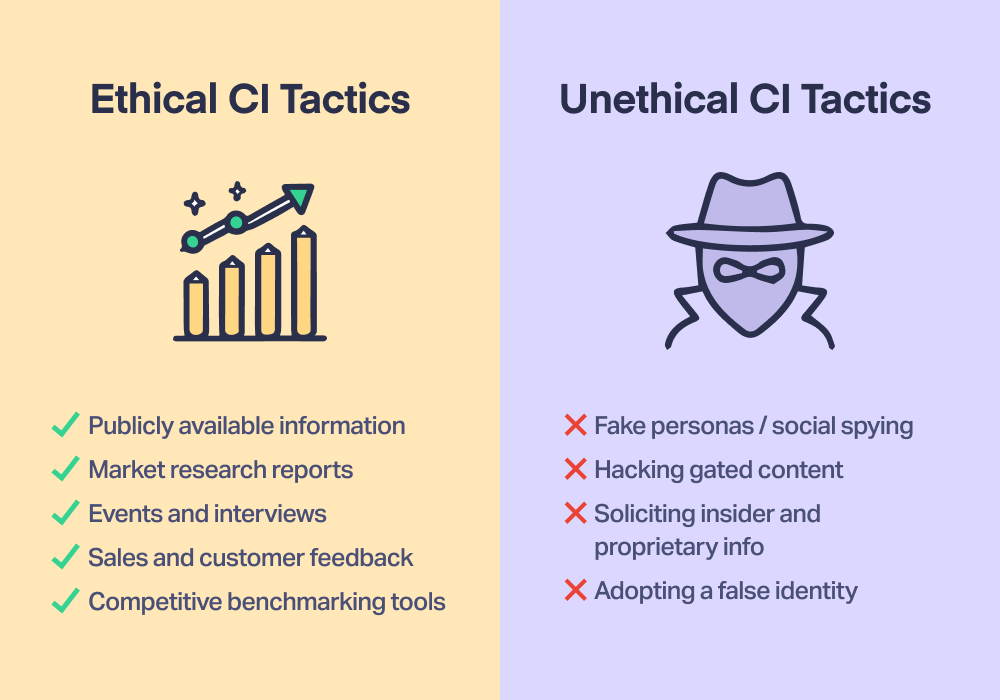
Publicly Available Digital Sources
Start with what’s already out there:
- Company websites: Track product updates, pricing changes, and new content with website change-monitoring tools.
- SEO and PPC analysis: Use platforms like Ahrefs, SEMrush, or SpyFu to analyze keyword strategies and ad placements entirely from public-facing data.
- Social media and forums: Follow competitors’ accounts and monitor public engagement or brand mentions using social listening tools.
- Job postings: Hiring trends can signal expansion plans or new product lines.
These digital traces are the foundation of modern competitive intelligence analysis, and they’re all above board.
Structured Market Research
Gain additional depth through formal research:
- Industry reports: Analyst firms like Gartner and Forrester publish vendor comparisons, market share insights, and trend forecasts.
- Government filings: Public companies disclose valuable info in SEC documents.
- Surveys: Conduct blinded market surveys to understand buying decisions, competitor preferences, and unmet needs.
This structured data often fills in the “why” behind competitor moves.
Pro Tip: Comparisons from review sites can often reveal feature gaps between you and your competitors. Take the G2 comparison of top inbound call tracking solutions below for example.
Events and Interviews
Live interactions offer a real-time perspective:
- Trade shows and conferences: Listen to competitor pitches, collect marketing collateral, and observe customer reactions ethically.
- Networking: Speak openly with partners or analysts who work across multiple vendors. Be transparent about your role and intentions.
- Analyst briefings: Ask for comparative insights from third-party experts.
The key: full disclosure of who you are and what you’re seeking.
Sales and Customer Feedback
Your own prospects are an untapped CI goldmine:
- Sales conversations: Encourage reps to log which competitors are mentioned and why.
- Call recordings: Tools like WhatConverts can automatically flag competitor names in inbound calls, then attribute those mentions to campaigns.
- Win/loss interviews: Ask why you won or lost a deal. Customers often provide direct, actionable insights about your competitors.
Because this data comes from your own interactions, it’s not only ethical. It’s often your most accurate source.
Pro Tip: WhatConverts makes it easy to mine for sales and customer feedback data. For example, you can use AI-powered keyword detection to find mentions of competitors on inbound lead calls or chats.
- Add the Keyword Detection dimension.

- Filter by your competitor's name.

- Drill down into the conversation for insights.
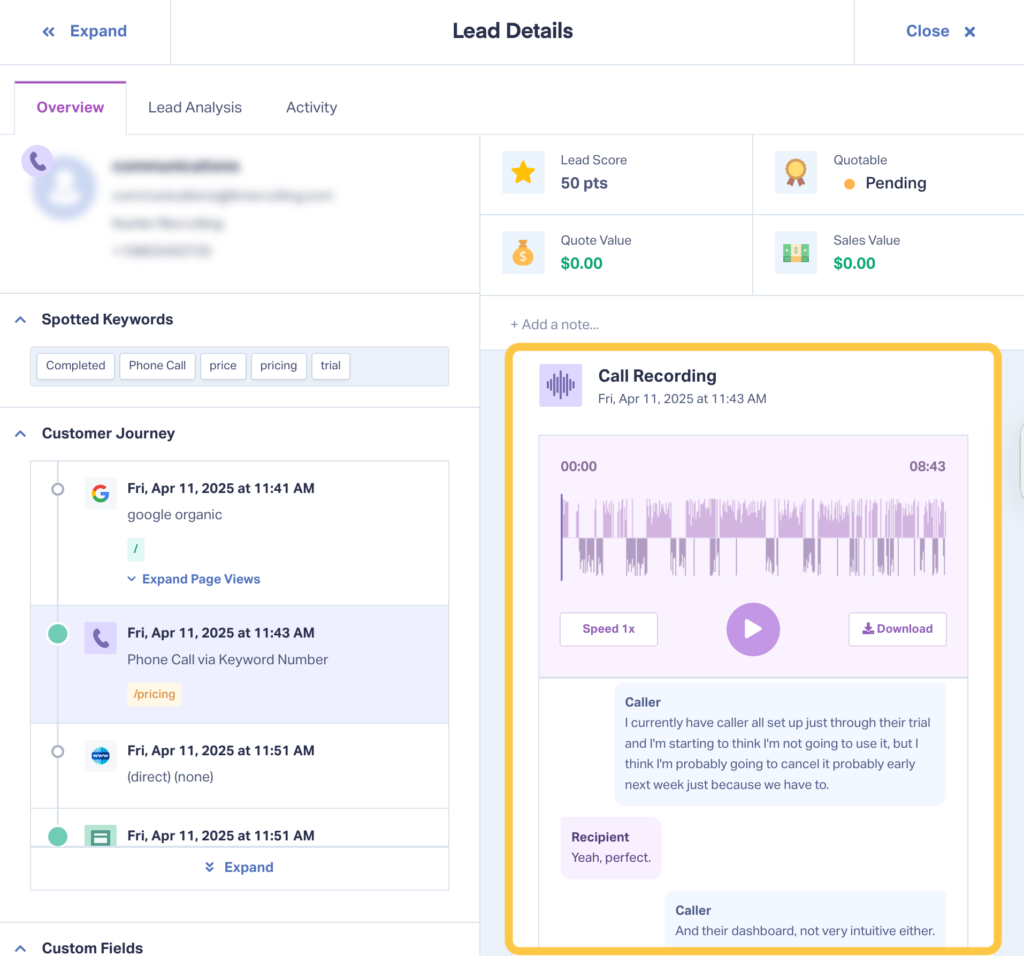
Related Resource: How to Find Your Best High-Intent Keywords
Competitive Benchmarking Tools
Modern software simplifies ethical CI:
- SEO/PPC benchmarking: See how you stack up on search visibility, ad spend, and ranking performance (we use Ahrefs).
- Social listening platforms: Track brand sentiment, share of voice, and influencer impact without breaching privacy or terms of service.
- CI dashboards: Aggregate alerts, competitor moves, and public signals in one place.
Choose tools that clearly filter out gated or private content and use only legally obtained data.
Key takeaway: Ethical competitive intelligence analysis doesn't limit your insights. It sharpens them. With the right sources and tools, you can uncover strategic opportunities, monitor competitor behavior, and guide smarter decisions without ever compromising your integrity.
What You Must Not Do: Unethical Tactics to Avoid

Misrepresentation or Fake Personas
Pretending to be someone you’re not (fake customer, student, job seeker) to extract intel from a competitor is unethical and often illegal. This includes:
- Creating false LinkedIn profiles to gain insider access
- Emailing competitors under fake names to request pricing
- Impersonating customers at trade show booths
Even if it seems harmless, it violates core CI ethics and can destroy your company’s credibility if discovered.
Hacking or Unauthorized Access
Accessing private systems or data you don’t have rights to is a criminal offense, not a CI tactic.
- Scraping behind login portals
- Circumventing paywalls
- Using tools to access restricted APIs or accounts
Under the Economic Espionage Act, even possessing stolen trade secrets can result in steep fines or prison time. Stick to data that’s made available to the public, or simply don’t use it.
Soliciting Confidential Information
Don’t pressure current or former employees, partners, or vendors to leak inside information. This includes:
- Asking new hires to share competitor roadmaps
- Requesting private decks shared under NDA
- Encouraging breaches of confidentiality agreements
If someone offers non-public competitor info unsolicited, the ethical move is to walk away or even report it. See the famous Pepsi response to a former Coca-Cola employee trying to sell company secrets. Instead of engaging, they reported it to the FBI.
Infiltrating Competitor Spaces
Joining a competitor’s private event, forum, or workspace under false pretenses crosses every ethical line.
- Applying for competitor jobs just to “spy”
- Attending customer-only webinars or groups while posing as a buyer
- Hiring investigators to covertly gather intel
These actions aren’t just unethical. They’re often legally actionable. No insight is worth the cost of being labeled as corporate spies.
Key takeaway: Competitive intelligence analysis must never involve deception, theft, or coercion. If a tactic feels like it would get you fired or featured on a front-page exposé, it’s off limits. The best CI professionals know that the high road leads to more sustainable success.
Turning Ethics into Business Value
Ethical competitive intelligence analysis isn’t just about avoiding risk. It’s a way to unlock smarter strategy, sharpen messaging, and improve win rates. When CI is conducted with integrity, it becomes a trusted source of insight that sales, marketing, and leadership teams can act on confidently.
Designing an Ethical CI Process
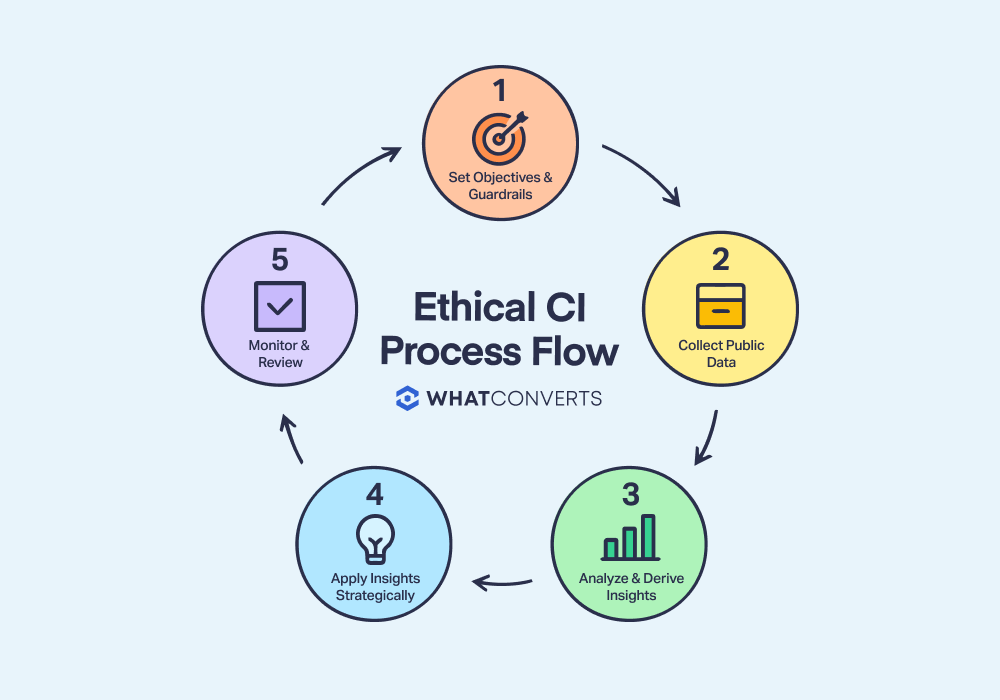
- Set measurable goals – Example: “Increase win rate vs. Competitor A by 15% in Q3.”
- Gather public signals – Use SEO/PPC tools, website monitors, and call transcript reviews to identify relevant trends ethically.
- Analyze and extract insights – Look for patterns. Did your losses correlate with a competitor’s pricing update? Are prospects mentioning a missing feature?
- Apply insights strategically – Adjust messaging, launch targeted campaigns, inform product development, or arm sales with counter-positioning.
- Monitor and refine – Create a feedback loop. Are your CI-driven actions improving results?
Sales Enablement with Integrity
Battlecards, objection handlers, and competitive one-pagers are only effective if they’re honest. Ethically sourced data like customer reviews, competitor websites, and transcribed prospect calls ensures your team can:
- Confidently address competitor claims
- Focus on verified feature comparisons
- Avoid spreading falsehoods that damage credibility
Customers can spot dishonest tactics. A truth-based sales approach not only wins more deals, it builds trust that lasts.
The Role of WhatConverts
WhatConverts adds unique value to ethical CI by turning inbound conversations into actionable data:
- Tracks competitor mentions in call transcripts and recordings thanks to keyword detection

- Links intel to source campaigns, showing where ex-competitor leads come from
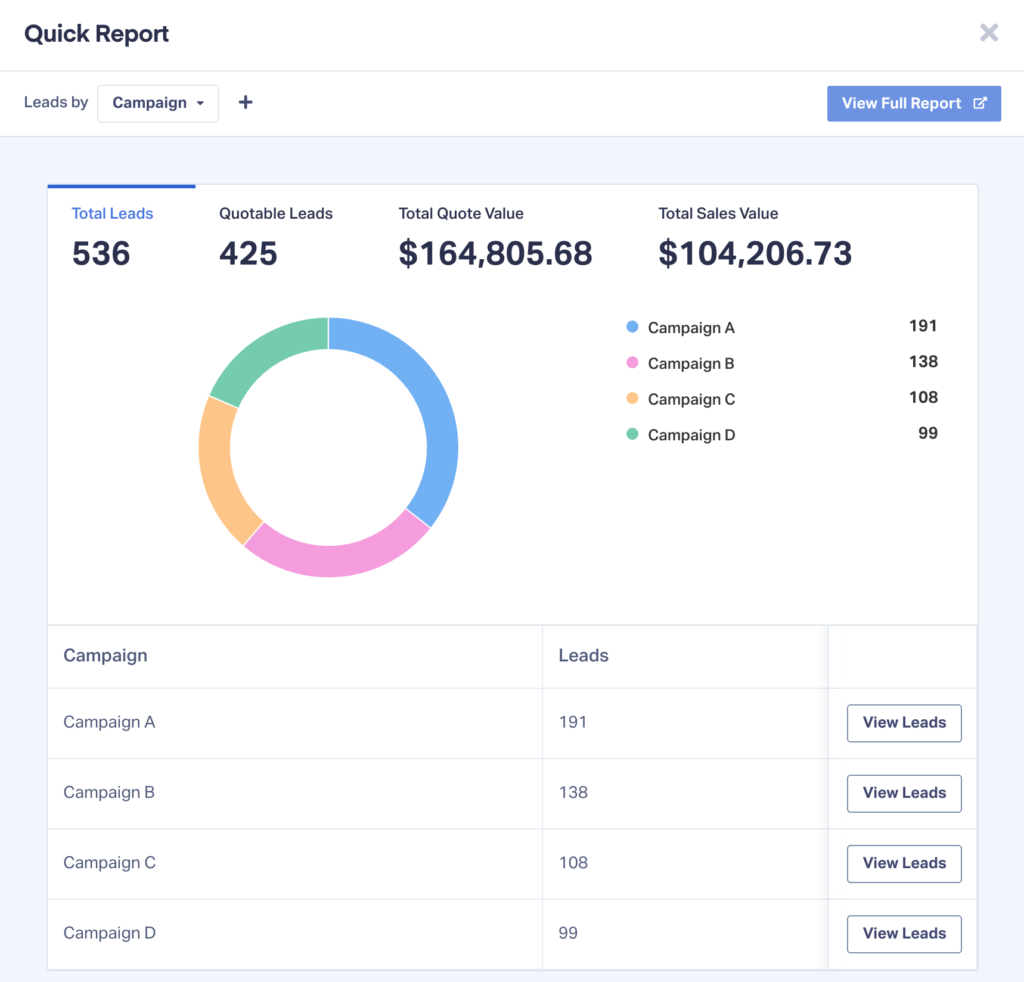
- Detailed conversation data so you can drill down into the specifics
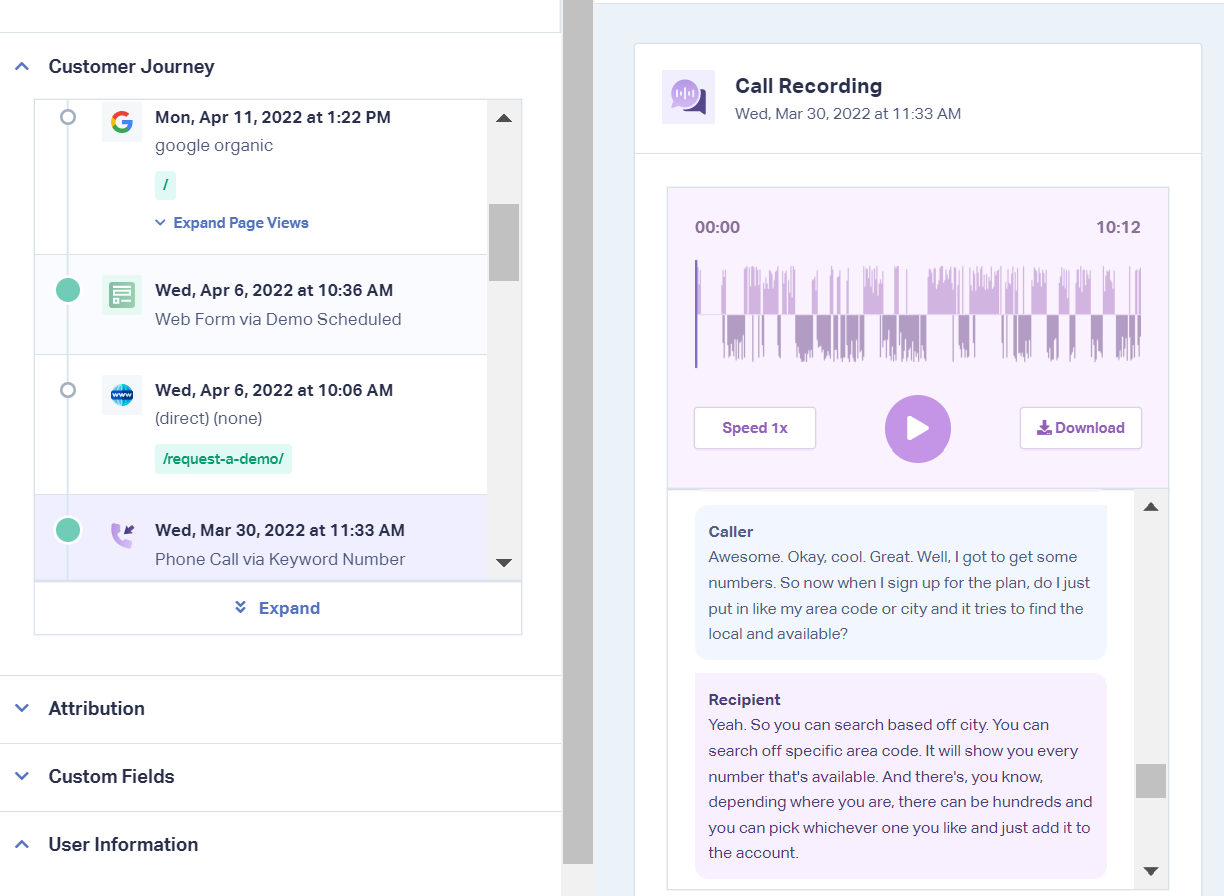
This is first-party data, willingly shared by your leads. It’s clean, legal, and powerful, especially when tied to attribution.
Example: If 90% of competitor switchers are coming from Ad Campaign A, you now have proof that the campaign is especially good at bringing in former users of your competitor.
Key takeaway: When done right, competitive intelligence analysis does more than keep you compliant. It drives revenue, refines strategy, and boosts team performance. The best part? You’ll never have to worry about it coming back to haunt you.
Conclusion: Win the Right Way
Competitive intelligence analysis doesn’t have to be risky, shady, or secretive. Done right, it’s one of the most powerful tools in a marketer’s playbook, delivering insight, sharpening strategy, and building trust instead of breaking it.
This guide has shown how to ethically gather intel from public sources, customer conversations, and structured research, and how to turn that insight into real business value. You don’t need covert tactics to compete. You need structure, integrity, and the right tools.
Ready to put ethical CI to work?
WhatConverts helps you capture competitor insights directly from your inbound leads, then ties them to marketing attribution, campaign performance, and sales outcomes.
Get a FREE presentation of WhatConverts
One of our marketing experts will give you a full presentation of how WhatConverts can help you grow your business.
Schedule a Demo
Grow your business with WhatConverts






